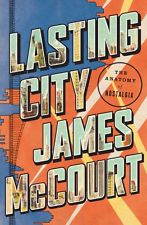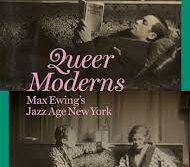 Lasting City: The Anatomy of Nostalgia
Lasting City: The Anatomy of Nostalgia
by James McCourt
Liveright Books / Norton
352 pages, $26.95
“OBTUSE and infuriating, but…” A brief survey of online reviews for James McCourt’s previous work of nonfiction, the 600-page Queer Street: Rise and Fall of an American Culture, 1947-1985 (2005), amply illustrates how sharply this idiosyncratic Irish-American genius divides his readers. Harold Bloom, Susan Sontag, John Waters, and Wayne Koestenbaum have acclaimed his genius. But McCourt’s dancing, teasing, polyphonous prose has proved too much for others. One armchair reviewer said of Queer Street that McCourt “makes Edmund White look like a minimalist.”
Critic Bloom aptly caught Queer Street’s rupturing of literary form, terming it an “extravagant edifice.” Poet J. D. McClatchy got still closer, trumpeting McCourt as a “divine ventriloquist of the era’s voices, whether lowbrow, midtown, or high camp.” Certainly, McCourt adopts, animates, and mythologizes Manhattan’s myriad “different voices.” If the result sometimes veers uncertainly between polyphonous epiphany and sheer cacophony, it certainly gives McCourt a narrative voice that cannot be mistaken for anyone else’s today.
Fans of McCourt’s highbrow, high-wire act may be forgiven for welcoming an eight-year gap between publications, for the rich, eccentric brazenness of his prose requires slow digestion. Its compression recalls Ronald Firbank, its elliptical qualities Djuna Barnes, its musicality James Joyce, and its prophetic timbre Samuel Beckett. McCourt may indeed be our planet’s last great modernist. His prose seems to pick up where Beckett’s left off, though McCourt is a far more humane and socially interested author. Just as Joyce and Beckett were able to capture Irish dialectic and Dublin life only while based abroad, so too McCourt—whose prime subject is always New York—has penned eight books chiefly in self-imposed exile, either in Washington, D.C., or in Ireland. Lasting City picks up from McCourt’s birth on July 4th, 1941, and (sort of) recounts his first five years in Jackson Heights, Queens, and in Northport, Long Island. But the real obsession, as in Queer Street, is with his early discovery of “the City”—Manhattan—and its utterly sui generis inhabitants. Nostalgia informs the journey, as the subtitle allows. The trigger of memory reorders a life story, since early incidents only reverberate now because they’re being reframed by later events. Wordsworth first noted that “the Child is father of the Man.” McCourt deploys his childhood to offer a journey through seven decades, since childhood can only be recalled by retracing this journey in the mind. His epigraph, from Freud, confirms this: “When we speak about the past we lie with every breath we take. Whoever turns biographer commits himself to lies, to concealment, to hypocrisy, to embellishments, and even to dissembling his own lack of understanding.” So, with a nod to the playfulness of Laurence Sterne’s Tristram Shandy, Lasting City only arrives at McCourt’s birth on page 123. By now we have already learned of his childhood alter ego or voice of conscience “Moriarty,” of his high school years in the opera club, also frequented by one Rudy Giuliani, of his subsequent idolization of opera diva Victoria de los Angeles, who in turn inspired his invented opera star, Mawrdew Czgowchwz, who in turn demanded that McCourt, her begetter, recount her life in a novel bearing her name. Lasting City is thus not only just as much an imaginative esprit as McCourt’s novels. It also somewhat accounts for their creative eccentricities. The young boy starts hearing voices—“a chorus of commentators to further the narration of the perhaps largely fanciful story of his life put forward by James Francis John McCourt, flamer and clown.” McCourt’s novelistic polyphony—what the Russian critic Bakhtin termed dialogism—can be seen as a sort of protective response to the implicit challenge to one’s sanity posed by hearing such voices. McCourt chose to harness them, and therefore to master them. Similarly, struck apparently by a form of Catholic guilt, the adolescent McCourt began writing himself letters to take stock of the many sexual explorations he engaged in with older men—at the Everard Baths, in the restrooms, and at the piers. Did conscience make McCourt a writer? If so, it is with humor that the author now remembers carrying a card in his wallet in case of misadventure or accident. It read simply: “I am a Catholic. Please call a Priest.” There may be an additional motivation, as expressed at the start of Lasting City: to extend his life. If not achievable in real terms, this can be possible through the alchemy of art, since “the transformation of a life into literature necessarily prolongs it.” More obviously, too, the death of his mother a decade ago seems to have enabled McCourt to write more honestly and fully about the extent of his erotic life and his unshakeable “longing for the gutter” instinct. Fans will learn much about his literary tastes. There are allusions to Beckett and Joyce, but also to Proust, Eugene O’Neill, Flaubert, Melville, Blake, Swift, Shakespeare, and even Ernest Dowson. There is also Rimbaud’s infamously ungrammatical formulation “Je est un autre” (“I is an other”), which helpfully explains the distinctive, third-person memoir form. But there is so much besides: a visit to the catacombs in Palermo, Sicily (the ultimate in High Camp for McCourt); the desire to strangle his mother and the unwavering idolization of his older brother, as well as the need to disparage his younger sibling; the formative experience of watching Maria Montez’ outrageously good/bad performance in Cobra Woman; the experience of raving madness in a cytomegalovirus-stricken friend, felled soon afterwards by AIDS; the glory hole and “its eerie Black Mass relationship to the confessional”; the visual arts, from Caravaggio to Pollock; and, of course, music, from Massenet to Ravel, from Tchaikovsky to Debussy. Then there are the portrait sketches, such as W. H. Auden, seen among the “mouthy, affluent, amazing queers and their attendant fucked-up boy losers” at Cherry Grove. McCourt even touches upon his first nervous breakdown at age eleven and, albeit obscurely, upon an apparent suicide attempt. There is a hostile reference to the Internet, followed up by the following observation: “You know, when the telephone was invented, people commenced to think they actually had something to say. Look what end that’s brought us to.” Elsewhere, McCourt explains how our digital world, with its mostly delusional sense of instant and universal celebrity, risks in fact demeaning and shortchanging all of us: “When everybody’s someone, then no one is anybody.” Later, reading a warm recollection of visits to the movies, I was struck that McCourt’s other subject, and the cause of Lasting City’s ubiquitous structuring principle of nostalgia, was nothing less than a vanishing, if not vanished, world: the pre-digital age. McCourt offers a paean to analog, to a time when human memory might be celebrated rather than considered as deficient, in need of propping up by the endless recirculation of images and words in virtual form. Our lives are thus obsessively recorded (and monitored) today, but scarcely ever evaluated or reflected upon. If this makes Lasting City sound entirely backward-looking, then it is so—in the best sense. Consider the poeticism with which celluloid pleasures are evoked by McCourt: “the memories as they come into consciousness do so in the very form of the motion picture itself—in master shot, two-shot, close-up, fade-out/fade-in, dialectical montage vs. mise-en-scène, the sortilège of silver nitrate.” At such moments, the warmth of our analog past is not only figurative, but literal—just as authentic, in fact, as the feeling that music lovers have, that there is an aural warmth in vinyl recordings that digital sound lacks. McCourt is among America’s most important and profound living writers. If his prose demands much of the reader, including much of our time, then it is perhaps time to question the poverty of our age, where it is invariably expected of the creative artist to engage with an audience on easy and instant terms, always ensuring, of course, that the artistic work proves “relevant” and doesn’t take the audience too far out of their “comfort zone.” The unique imaginative capabilities of this author, too, were clearly evident very early on. An image I will always cherish is of the tiny McCourt building his sandcastle earnestly on the beach—only to have a gang of youths traipse over and demolish it. The design of the sandcastle? A perfect replica of the Flatiron Building. What else, when it is in your nature to be this ambitious? Richard Canning’s most recent publication is a 2012 edition of Ronald Firbank’s Vainglory for Penguin Classics.




